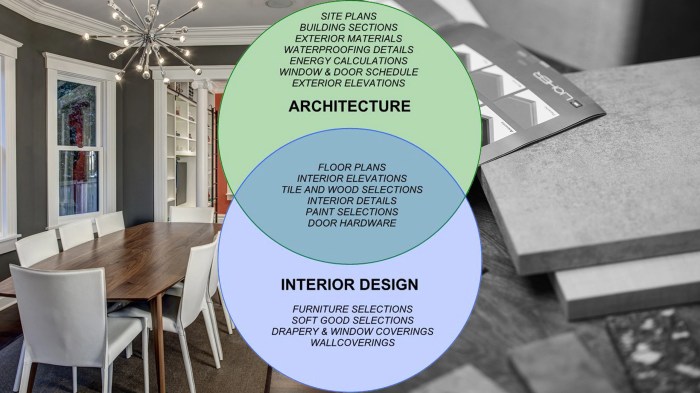Delve into the realm of architecture and interior design as we uncover the intricate roles and fascinating responsibilities that architects and interior designers hold. From educational requirements to design processes, this captivating journey will showcase the unique blend of creativity and technical expertise in these fields.
Roles and Responsibilities
An architect plays a crucial role in a project by designing and overseeing the construction of buildings, ensuring that they are functional, safe, and aesthetically pleasing. They are responsible for creating the overall design concept, preparing detailed drawings and specifications, obtaining necessary permits, and working closely with clients, engineers, and contractors to bring the project to life.Interior designers, on the other hand, focus on the interior spaces of a building, including the layout, furnishings, colors, and finishes.
Their responsibilities include understanding the client's needs and preferences, creating design concepts, selecting materials and furniture, and coordinating with architects and contractors to ensure that the interior design aligns with the overall vision of the project.
Comparison of Duties
- Architects are primarily concerned with the overall structure and exterior appearance of a building, while interior designers focus on creating functional and aesthetically pleasing interior spaces.
- Architects work on the building as a whole, considering factors such as site conditions, building codes, and structural integrity, whereas interior designers concentrate on the details that enhance the interior environment.
- While architects may be involved in the initial planning stages of a project, interior designers typically come into play during the later stages to add finishing touches and create a cohesive design scheme.
- Both architects and interior designers collaborate with clients to understand their needs and preferences, but architects are more focused on the overall building design, while interior designers specialize in creating inviting and functional interior spaces.
Education and Training

To become an architect, individuals must complete a professional degree in architecture, typically a Bachelor of Architecture (B.Arch) or a Master of Architecture (M.Arch) from a program accredited by the National Architectural Accrediting Board (NAAB).
Architect Educational Requirements
- Completion of a Bachelor's or Master's degree in Architecture
- Participation in an internship program, typically lasting 3 years
- Passing the Architect Registration Examination (ARE) to become licensed
Interior Designer Training
Interior designers typically pursue a Bachelor's degree in Interior Design or a related field. Additionally, gaining practical experience through internships or entry-level positions is crucial to develop skills and industry knowledge.
Differences in Educational Paths
Architects focus on the design and construction of buildings, requiring specialized knowledge in structural systems and building codes. Interior designers, on the other hand, concentrate on interior spaces, emphasizing aesthetics, functionality, and furnishings.
Design Process
When it comes to the design process, architects and interior designers follow a systematic approach to ensure the successful completion of a project. While there are similarities in the steps involved, there are also key differences in how architects and interior designers execute the design process.
Architects
Architects typically follow a design process that involves several key steps:
- Programming: Understanding the client's needs and requirements for the project.
- Schematic Design: Developing initial design concepts and sketches.
- Design Development: Refining the chosen concept and developing detailed drawings.
- Construction Documents: Creating technical drawings and specifications for construction.
- Permitting: Obtaining necessary approvals and permits for the project.
- Construction Administration: Overseeing the construction process to ensure the design is implemented correctly.
Interior Designers
Interior designers also have a structured design process that includes the following steps:
- Initial Consultation: Meeting with the client to understand their preferences and requirements.
- Concept Development: Creating a design concept that aligns with the client's vision.
- Design Presentation: Presenting the proposed design concept, including color schemes, materials, and furniture selections.
- Design Development: Refining the design based on client feedback and finalizing details.
- Implementation: Overseeing the execution of the design plan, including procurement and installation.
Differences in Design Processes
While both architects and interior designers focus on creating functional and aesthetically pleasing spaces, their design processes differ in terms of scope and focus. Architects typically work on the overall structure and exterior of a building, while interior designers focus on the interior spaces and furnishings.
Additionally, architects often collaborate with engineers and contractors to ensure the structural integrity of a building, while interior designers work closely with clients and vendors to select furnishings and finishes.
Collaboration and Communication
Effective collaboration and communication between architects and interior designers are crucial for the success of any project. Architects and interior designers often work hand in hand to create cohesive and functional spaces that meet the needs and vision of the clients.
Collaboration Process
Architects and interior designers collaborate right from the initial stages of a project, such as conceptualization and space planning. Architects focus on the structural elements and overall design of the building, while interior designers concentrate on the aesthetics, furniture, fixtures, and finishes.
By sharing ideas, feedback, and expertise, they ensure that the final design seamlessly integrates both the exterior and interior aspects of the space.
Importance of Communication
Effective communication is essential to ensure that the architectural and interior design elements complement each other harmoniously. Clear and open communication helps prevent misunderstandings, ensures alignment on project goals, and enables timely decision-making. Architects and interior designers must communicate regularly throughout the project to address any challenges, changes, or new requirements that may arise.
Examples of Successful Collaborations
One notable example of successful collaboration between architects and interior designers is the Guggenheim Museum in Bilbao, Spain. Architect Frank Gehry's iconic design seamlessly integrates with the interior spaces curated by renowned interior designer Andrée Putman. The result is a stunning architectural masterpiece that not only showcases Gehry's vision but also highlights Putman's expertise in creating a cohesive and visually impactful interior environment.
This collaboration between two creative minds led to a globally recognized landmark that continues to inspire and captivate visitors from around the world.
Project Examples
Let's delve into some notable architectural and interior design projects to understand the design approaches and concepts.
Architectural Project: Sydney Opera House
The Sydney Opera House, designed by Danish architect Jørn Utzon, is a renowned architectural marvel known for its iconic sail-like shells. Utzon's design approach focused on creating a structure that harmonized with the natural surroundings while symbolizing Australia's maritime culture.
The innovative use of precast concrete shells and intricate geometric forms showcases Utzon's visionary architectural style.
Interior Design Project: The Louvre Abu Dhabi
The interior design of The Louvre Abu Dhabi, led by renowned architect Jean Nouvel, embodies a concept of 'museum city' under a vast dome. Nouvel's design approach aimed to create a cultural hub that merges art, architecture, and nature seamlessly.
The use of natural light filtering through the dome and the juxtaposition of artworks from different cultures reflect Nouvel's vision of a universal museum experience.
Comparison of Architectural and Interior Design Elements: Guggenheim Museum Bilbao
The Guggenheim Museum Bilbao, designed by architect Frank Gehry, exemplifies a fusion of architectural and interior design elements in a unique way. Gehry's unconventional use of titanium panels for the exterior creates a dynamic and sculptural form that extends seamlessly into the interior spaces.
The fluidity of design in both the architecture and interior layout of the museum blurs the boundaries between art and architecture, offering visitors a transformative spatial experience.
Final Review
As we conclude this exploration of architects and interior designers, we reflect on the symbiotic relationship between these professionals. Their collaborative efforts, innovative design processes, and successful project examples highlight the transformative impact they have on the spaces we inhabit.
Questions Often Asked
What are the key differences between the roles of an architect and an interior designer?
Architects focus on the overall structure and design of a building, while interior designers specialize in creating functional and aesthetic interior spaces.
What are the typical educational paths to become an architect or interior designer?
Architects usually require a professional degree in architecture and licensure, whereas interior designers may pursue a degree in interior design or related field.
How do architects and interior designers collaborate on projects?
Architects and interior designers work together to ensure that the exterior and interior design elements of a space harmonize and complement each other.
Can you provide examples of successful collaborations between architects and interior designers?
Projects like the Sydney Opera House and the Louvre Pyramid demonstrate the seamless collaboration between architects and interior designers in creating iconic spaces.












